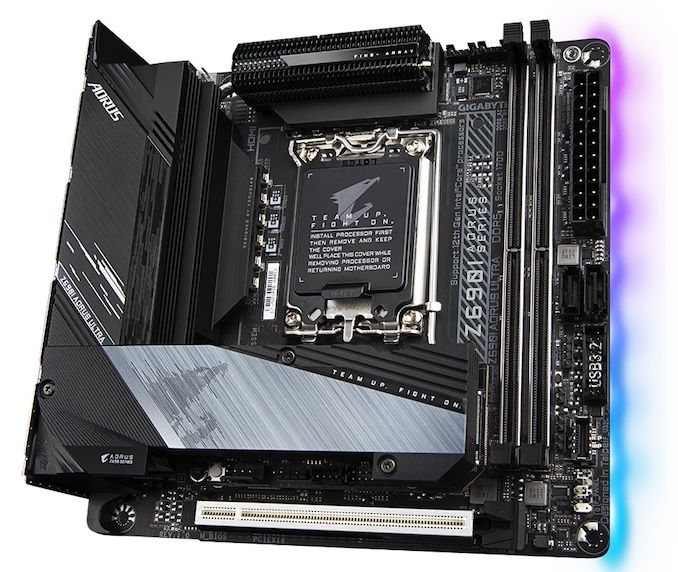The Intel Z690 Motherboard Overview (DDR5): Over 50+ New Models
by Gavin Bonshor on November 9, 2021 9:00 AM ESTGIGABYTE Z690I Aorus Ultra
Providing options for small form factor users, there is always a large gap between the number of ATX and smaller form factors at any given chipset launch. The GIGABYTE Z690I Aorus Ultra is the smaller sibling of the ATX sized Z690 Ultra, and as such, follows a similar principle in terms of its controller set and aesthetic. Along the right-hand side of the PCB creating an underglow effect is a strip of RGB LEDs, while the board has a black and silver theme with a grey and black patterned PCB. GIGABYTE is also advertising a 10-phase design for the CPU, with the latest 105 A premium power stages.
As this is a mini-ITX sized motherboard, the Aorus Z690I Ultra has just one full-length PCIe 5.0 x16 slot, with dual PCIe 4.0 x4 M.2 slots. For conventional storage, GIGABYTE includes just two SATA ports, with support for RAID 0, and 1 array. Located to the right-hand side of the LGA1700 socket is a pair of memory slots, which can support up to DDR5-6200, with a combined capacity of up to 64 GB.
Looking at rear panel connectivity, GIGABYTE includes one USB 3.2 G2x2 Type-C, three USB 3.2 G2 Type-A, two USB 3.2 G1 Type-A, and two USB 2.0 ports. Users looking to use Intel's integrated graphics can do so via one HDMI and one DisplayPort video output pairing, while onboard audio support consists of two 3.5 mm audio jacks powered by a Realtek ALC4080 HD audio codec. Finishing off the rear panel is a single Intel I225-V 2.5 GbE controller and Intel AX201 Wi-Fi 6 CNVi pairing, while GIGABYTE also includes a small Q-Flash BIOS Flashback button.












126 Comments
View All Comments
mode_13h - Friday, November 12, 2021 - link
I was really disappointed not to see more discussion of costs and why the price distribution of these boards tends to skew so high.However, I was most surprised to see how much lower some of the entry-level models are priced. Do we think these will be produced in sufficient volume, or are they primarily there as a means of upselling would-be buyers who, out of frustration at seeing them always out-of-stock eventually end up buying one of the more expensive models?
mikk - Saturday, November 13, 2021 - link
MSI Pro Z690-A WIFI, MSI Pro Z690-A and many more have the cheaper Realtek ALC897 Codec, the audio table is not accurate and it says Z490 instead of Z690.ajollylife - Sunday, November 14, 2021 - link
Wtf is with the PCIe 3.0 slots? I'm looking at the Gigabyte Aorus Master, has 10gig onboard, great, but then the other two pcie slots are pcie 3.0 So confused.mode_13h - Sunday, November 14, 2021 - link
From what I've read, PCIe 4.0 tends to require retimers, which adds cost and takes space. Those could be reasons why we don't see more PCIe 4.0 slots.back2future - Monday, November 15, 2021 - link
maybe mainboards start getting reshaped/redesigned (vertical m.2, backside slots/connectors, ?) instead of using retimers (chipset TDP includes retimer power?, cooling power for peripherals on PCIe 5.x speeds on 4GB/(s*lane)=~2 lanes sufficient for fastest available (2021, consumer) SSDs )?ecclesiastes121314 - Wednesday, February 23, 2022 - link
2 ram slots? I've seen this on a few of these new DDR5 boards. Most people here are talking about Thunderbolt 4 and USB4. Yes these are very useful to a select group of people yet these can be achieved with add on cards. Then you can pay for the devices to take advantage of these technologies. Reducing ram slots from 4 to 2. Wow. Yes you can buy high density ram. But this is forcing you that direction. What is wrong with 4x16 or 4x32 ram kits? If you (me) are interested in high performance video then affordable and available ram is a huge consideration. Is it just me?